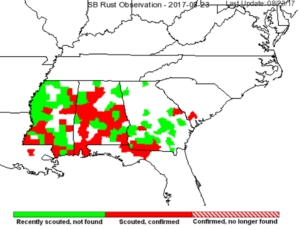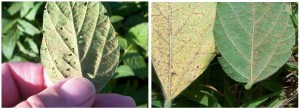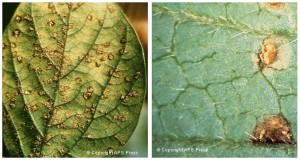South Carolina announced its first find of Asiatic Soybean Rust this year, in Hampton County. The soybeans were at stage R3 (early pod development), and only one of 50 leaves showed any detectable pustules. This is a little closer to many of our NC soybeans than any of the previously confirmed finds, at 380 miles from Elizabeth City, 265 miles from Raleigh, 310 miles from Washington, and 215 miles from Wilmington. The closest find to Murphy is a find in Morgan County, Alabama, which is approximately 165 miles from Murphy, and 350 miles from Charlotte. Burke County, GA is still the closest find to Charlotte (165 miles), Fayetteville (225 miles), and Winston-Salem (235 miles).
Asiatic soybean rust causes superficial, tan to reddish-brown lesions that are most likely to be observed on the underside of leaves. The lesions contain rust pustules which are raised on the surface and may have an angular appearance. The pustules are very small (about the size of a pin head) so they are difficult to see without a hand lens. The disease is a concern because it has the potential to defoliate a crop fairly quickly, in just a few weeks.
Most North Carolina growers probably aren’t very familiar with soybean rust since it’s typically not a problem in the state, but if you suspect rust contact your county agent or consultant to confirm. If you do find rust, the stage of your crop will largely influence treatment decisions. In fields with full sized beans in the top of the plant, it is probably not profitable to treat at all as these plants will be reaching maturity and dropping leaves on their own very shortly. In fields where the beans are not yet full size in the top of the plant, treatment is probably a good idea as the rust has the potential to defoliate the plant before it’s ready, resulting in yield loss.
We recommend spraying a fungicide to prevent infection of ASR on soybeans if ASR is confirmed on soybeans within 100 miles of your field, and the soybeans are between first bloom and stage R5 (early seed development). Since ASR is currently more than 100 miles away, we do not recommend spraying at this time, but it is important to monitor the situation over the next few weeks.
The current status of rust in the continental US can be found anytime at http://sbr.ipmpipe.org.
Soybean Rust Update: Aug 23, 2017 from Dr. Jim Dunphy & Dr. Lindsey Thiessen, NCSU.










